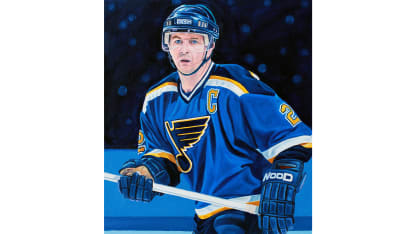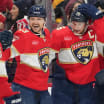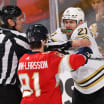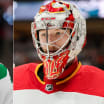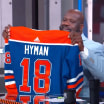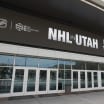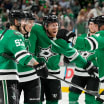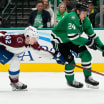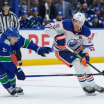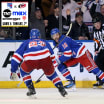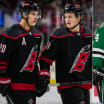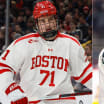As part of the NHL Centennial Celebration, renowned Canadian artist Tony Harris will paint original portraits of each of the 100 Greatest NHL Players presented by Molson Canadian as chosen by a Blue Ribbon panel. NHL.com will reveal two portraits each Monday in 2017.
This week, the portraits of forward Sergei Fedorov and defenseman Al MacInnis are unveiled in the 35th installment.
Fedorov, MacInnis portraits unveiled
Color paintings of 100 Greatest NHL Players will be revealed on NHL.com every Monday in 2017
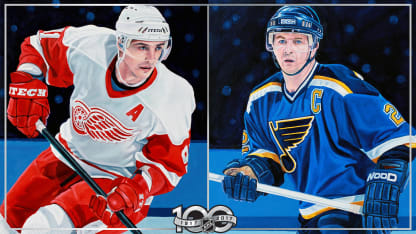
By
NHL.com @NHLdotcom
There wasn't much that
Sergei Fedorov
couldn't do on a hockey rink.
Score? He was second in the NHL with 120 points (56 goals, 64 assists) in 1993-94, when he won the Hart, Pearson and Selke trophies, and his 1,179 points (483 goals, 696 assists) are the most of any Russian-born player in League history.
Defend? He repeated as the Selke winner in 1996, finished his NHL career plus-276 and even took a regular turn on defense during the 1996-97 season, when injuries left the Red Wings undermanned.
Win? He played on three Stanley Cup championship teams with the Detroit Red Wings (1997, 1998 and 2002).
Fedorov was supposed to be part of the next great line in Soviet hockey. He and linemates Alexander Mogilny and Pavel Bure led the Soviets to the gold medal at the 1989 IIHF World Junior Championship, with all three among the tournament's top scorers. But the Red Wings, who selected Fedorov in the fourth round (No. 74) in the 1989 NHL Draft, convinced him to defect during the 1990 Goodwill Games in Portland, Oregon.
He quickly became a cornerstone on an up-and-coming Detroit team, finishing second in balloting for the Calder Trophy in 1990 and later becoming part of the "Russian Five" unit that was periodically used by coach Scotty Bowman.
Fedorov remained with the Red Wings through the 2002-03 season before signing with the Mighty Ducks of Anaheim. He also played with the Columbus Blue Jackets and Washington Capitals, where he helped mentor a young Alex Ovechkin, who went on to surpass Fedorov as the NHL's all-time goal-scoring leader among Russian-born players.
In his
NHL100 profile of Fedorov
, author Stu Hackel described the future NHL star's development:
"Soviet hockey officials began scouting him at 13. He moved to Minsk before he turned 16 to play in the Soviet league's second division for one season, then moved to Moscow in 1986 to be mentored by Viktor Tikhonov at CSKA, the Red Army Team. Selected to the Soviet national junior squad, Fedorov was named to the 1988 World Junior Championship All-Tournament Team after the Soviet Union won a silver medal. They won gold the next year, with Fedorov and his wings, Alex Mogilny and Pavel Bure, among the top scorers.
"Meanwhile, the Red Wings were rebuilding and weighed drafting Fedorov. They considered him the world's top 18-year-old, but understood Soviet picks might end up wasted picks. GM Jim Devellano was willing to take the risk. Over the next year, the Red Wings quietly persuaded Fedorov to defect, which he did in the summer of 1990 when the Soviet national team played in Portland. Arriving in Detroit, he selected jersey number 91, the reverse of Yzerman's 19.
"'He told me he wanted to be like Stevie,'" Red Wings equipment manager Mark Brennan said.
"'He has a dazzling, up-tempo style that reminds some of a young Gilbert Perreault," wrote Joe Lapointe in The New York Times with Fedorov one month into his NHL career. "'A center, Fedorov kills penalties, skates on the power play and sets up teammates so quickly that his passes sometimes surprise them.'
"His 79-point rookie season earned Calder Trophy runner-up honors. Three seasons later he'd be recognized as one of the game's best players."
Artist Tony Harris said one thing he enjoyed about painting Fedorov is that the lack of change in the Red Wings' uniform over the decades provides a consistency that many other teams don't have.
"One of the things I love about the Detroit Red Wings uniform is how it has remained relatively unchanged since 1932," he said. "With this in mind, I find it cool that the paintings of Gordie Howe, Ted Lindsay and Alex Delvecchio (apart from their gloves and lack of head gear) will be in the same uniform as Steve Yzerman, Nicklas Lidstrom and Fedorov.
In contrast to Fedorov,
Al MacInnis
was a first-round pick (No. 15) by the Calgary Flames in the 1981 NHL Draft whose route to stardom had more than a few bumps along the way.
MacInnis' booming slap shot helped him tie Bobby Orr's Ontario Hockey League record for goals by a defenseman (38 in 1982-83). However, as with most young defensemen, the defensive side of his game needed work. But he worked to improve defensively; by 1985, MacInnis was selected to play in the NHL All-Star Game for the first of 12 times. In 1989, he powered the Flames to the Stanley Cup and won the Conn Smythe Trophy as playoff MVP after finishing with 31 points (seven goals, 24 assists) in 22 games.
In 1990-91, MacInnis became the fourth defenseman in NHL history to score 100 points in a season. He finished with 103 (28 goals, 75 assists) and was a First-Team All-Star for the second straight season.
The Flames traded MacInnis to the St. Louis Blues on July 4, 1994, and he teamed with Chris Pronger to form one of the League's best defense pairings. In 1998-99, the 35-year-old led all NHL defensemen with 62 points and won the Norris Trophy.
In his
NHL100 profile of MacInnis
, author George Johnson looked back at the Hall of Fame defenseman's performance in Calgary's run to the Cup in 1989:
"During the Flames' run to the Stanley Cup in 1989, MacInnis scored seven goals, including one in overtime in Game 4 at the Chicago Blackhawks in the semifinals to give Calgary a 3-1 series lead, and finished with 24 assists in 22 games.
"On the ice at the fabled Montreal Forum, MacInnis experienced a double dose of achievement and joy, hoisting both the Stanley Cup and the Conn Smythe Trophy as postseason MVP. And so, amid the bedlam encircling him, he got to deliver the 'I'm going to Disney World!' slogan in the TV spot that was all the rage at the time.
"'Oh yeah,''' he said later with a laugh about the moment. "'They were on the ice with a camera. It was set up before the game -- if this happens, we'll be there and this is what you say. And so, I said: 'I'm going to Disney World!' 'Why not? I'm not turning down a free trip.
"'Thinking back, that Stanley Cup is the one thing I'm proudest of in my career. No question. That's what you dream about as a kid, on the street or down at the local rink. Someone's Danny Gallivan, announcing the game, right? And everyone is pretending to be their favorite player.
"'And you always win Game 7, score the big goal and get to lift the Cup.
"'And there I was, living that dream.'"
To Harris, MacInnis' slap shot was unlike any he's ever seen.
"Watching Al MacInnis on TV and listening to announcers tell us how hard his slap shot was gave me an idea of how powerful he was," Harris said. "Then I saw him live in the Forum in Montreal and the sound that his shots made was different than any other player. It was like watching a 21-year-old Tiger Woods hitting driver for the first time -- fast, hard and loud.
Sergei Fedorov
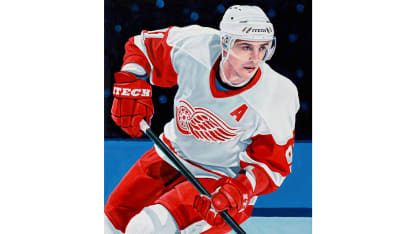
Al MacInnis
